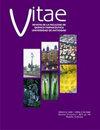Voltammetric Determination of Ascorbic Acid in Pharmaceutical Formulations Using Modified Iodine-Coated Platinum Electrode
Q3 Pharmacology, Toxicology and Pharmaceutics
引用次数: 6
Abstract
Background: Despite the high reactivity of the platinum electrode, the iodine-coated platinum electrode shows obvious inertness toward adsorption and surface processes. For that, iodine-coated platinum electrodes accommodate themselves to interesting voltammetric applications. Objectives: This study reports using the modified iodine-coated polycrystalline platinum electrode as a voltammetric sensor for ascorbic acid determination in pharmaceutical formulations. Methods: The developed voltammetric method based on recording cyclic voltammograms of ascorbic acid at iodine-coated electrode The optimized experimental parameters for the determination of ascorbic acid were using 0.1 M KCl as a supporting electrolyte with a scan rate of 50mV/s. Results: The anodic peak related to ascorbic acid oxidation was centered at nearly 0.28V. An excellent and extended linear dependence of the oxidative peak current on the concentration of ascorbic acid was observed in the range 2.84x10-3 - 5.68 mM. The limit of detection (LOD) and limit of quantitation (LOQ) were 1.0 µM and 3.01 µM, respectively, attesting to the method’s sensitivity. The investigation for the effect of potential interference from multivitamin tablet ingredients (vitamins B1, B6, B12, folic acid, citric acid, sucrose, glucose, and zinc) indicated specific selectivity toward ascorbic acid and the absence of any electrochemical response toward these components. Recovery results in the range 98.93±2.78 - 99.98±5.20 for spiked standard ascorbic acid in pharmaceutical formulations further confirmed the potential applicability of the developed method for the determination of ascorbic acid in real samples. Conclusions: The developed method was successfully applied to the analysis of ascorbic acid (vitamin C), and the obtained results were in good agreement with the labeled values; besides, the statistical tests indicated no significant difference at p=0.05 with a 95% confidence level.用修饰碘包覆铂电极伏安法测定药物制剂中的抗坏血酸
背景:尽管铂电极具有较高的反应活性,但碘包覆铂电极对吸附和表面过程表现出明显的惰性。为此,碘涂层铂电极适应于有趣的伏安应用。目的:本研究报道了用修饰碘包覆多晶铂电极作为测定药物制剂中抗坏血酸的伏安传感器。方法:建立了在碘包覆电极上记录抗坏血酸循环伏安的伏安法,优化的测定抗坏血酸的实验参数为:以0.1 M KCl为支撑电解质,扫描速率为50mV/s。结果:与抗坏血酸氧化有关的阳极峰集中在0.28V附近。氧化峰电流与抗坏血酸浓度在2.84 × 10-3 ~ 5.68 mM范围内呈良好的线性关系,检测限(LOD)和定量限(LOQ)分别为1.0µM和3.01µM,证明了该方法的灵敏度。对复合维生素片成分(维生素B1、B6、B12、叶酸、柠檬酸、蔗糖、葡萄糖和锌)的潜在干扰影响的研究表明,复合维生素片对抗坏血酸具有特定的选择性,并且对这些成分没有任何电化学反应。加标抗坏血酸在98.93±2.78 ~ 99.98±5.20范围内的回收率进一步证实了所建立的方法对实际样品中抗坏血酸测定的潜在适用性。结论:所建立的方法可用于抗坏血酸(维生素C)的分析,所得结果与标签值吻合较好;经统计学检验,p=0.05,置信水平95%,差异无统计学意义。
本文章由计算机程序翻译,如有差异,请以英文原文为准。
求助全文
约1分钟内获得全文
求助全文
来源期刊

Vitae
PHARMACOLOGY & PHARMACY-
CiteScore
1.20
自引率
0.00%
发文量
0
审稿时长
>12 weeks
期刊介绍:
The journal VITAE is the four-monthly official publication of the School of Pharmaceutical and Food Sciences, and its mission is the diffusion of the scientific and investigative knowledge in the various fields of pharmaceutical and food research, and their related industries. The Journal VITAE is an open-access journal that publishes original and unpublished manuscripts, which are selected by the Editorial Board and then peer-reviewed. The editorial pages express the opinion of the Faculty regarding the various topics of interest. The judgments, opinions, and points of view expressed in the published articles are the responsibility of their authors.
 求助内容:
求助内容: 应助结果提醒方式:
应助结果提醒方式:


